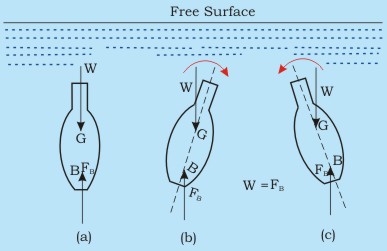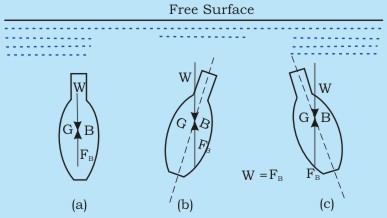Stability of Unconstrained Submerged Bodies in Fluid
-
The equilibrium of a body submerged in a liquid requires that the weight of the body acting through its cetre of gravity should be colinear with an equal hydrostatic lift acting through the centre of buoyancy.
-
In general, if the body is not homogeneous in its distribution of mass over the entire volume, the location of centre of gravity G does not coincide with the centre of volume, i.e., the centre of buoyancy B.
Depending upon the relative locations of G and B, a floating
or submerged body attains three different states of
equilibrium-
Let us suppose that a body is given a small angular displacement and then released. Then it will be said to be in
- Stable Equilibrium: If the body returns to its original position by retaining the originally vertical axis as vertical.
- Unstable Equilibrium: If the body does not return to its original position but moves further from it.
- Neutral Equilibrium: If the body neither returns to its original position nor increases its displacement further, it will simply adopt its new position.
Stable Equilibrium
Consider a submerged body in equilibrium whose centre of gravity is located below the centre of buoyancy (Fig. 5.5a). If the body is tilted slightly in any direction, the buoyant force and the weight always produce a restoring couple trying to return the body to its original position (Fig. 5.5b, 5.5c).


Fig 5.5 A Submerged body in Stable Equilibrium
Unstable Equilibrium
On the other hand, if point G is above point B (Fig. 5.6a), any disturbance from the equilibrium position will create a destroying couple which will turn the body away from its original position (5.6b, 5.6c).


Fig 5.6 A Submerged body in Unstable Equilibrium
Neutral Equilibrium
When the centre of gravity G and centre of buoyancy B coincides, the body will always assume the same position in which it is placed (Fig 5.7) and hence it is in neutral equilibrium.


Fig 5.7 A Submerged body in Neutral Equilibrium
Therefore, it can be concluded that a submerged body will be in stable, unstable or neutral equilibrium if its centre of gravity is below, above or coincident with the center of buoyancy respectively (Fig. 5.8).

Fig 5.8 States of Equilibrium of a Submerged Body
(a) STABLE EQUILIBRIUM (B) UNSTABLE EQUILIBRIUM (C) NEUTRAL EQUILIBRIUM
|